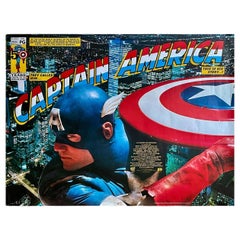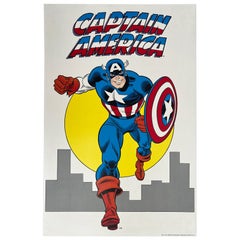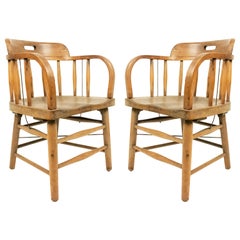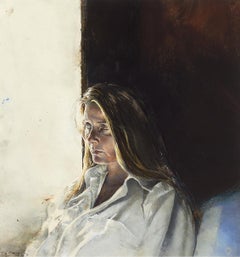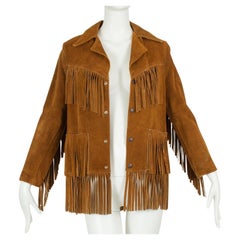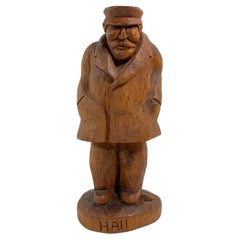Vintage Captain America
to
7
70
19
91
46
21
20
8
6
5
5
4
3
9
3
2
2
1
Sort By
Captain America (1990)
Located in London, GB
Captain America (1990)
Original British Quad (30 X 40 Inches)
Incredibly rare, original UK quad
Category
1990s Vintage Captain America
Materials
Paper
"Captain America", 1980s Vintage US Poster
Located in Bath, Somerset
Wonderful vintage 1980s US poster from for Marvel's Captain America. Super design and very cool
Category
20th Century American Vintage Captain America
Materials
Linen, Paper
Captain America 1991 Marvel Door Panel Poster
Located in Bath, Somerset
Wonderful vintage 1991 US poster from for Marvel's Captain America. This Supersized door panel is
Category
20th Century American Vintage Captain America
Materials
Paper, Linen
13 American Captain's Style Oak Armchairs
Located in Queens, NY
13 American (19/20th Century) oak captain's-style armchairs with spindle backs. (priced each).
Category
20th Century American Country Vintage Captain America
Materials
Wood, Oak
Pair of Cushman Furniture Co. Early American Carved Wood Captain's Dining Chairs
By H.T. Cushman Manufacturing Company
Located in East Freetown, MA
Pair of Cushman Furniture Company carved wood early American style captains chairs (with arms
Category
Late 20th Century American American Craftsman Vintage Captain America
Materials
Wood
$528 Sale Price
34% Off
H 34 in W 24 in D 22 in
The Captain's Lady
By Stephen Scott Young
Located in Miami, FL
introspection.
Inscribed on verso: " The Captain's Lady"
Leslie of ____________ St. Agustine, Florisa
SS
Category
1980s American Realist Vintage Captain America
Materials
Watercolor, Board
Cinnamon Suede Fringed Western Easy Rider Jacket – Women’s S / Men's XXS, 1960s
Located in Tucson, AZ
(where Billy and Wyatt started their trip). Captain America chopper sold separately.
Western style
Category
1960s Mexican Vintage Captain America
$450
Size: none; compare to women S men XXS
Nantucket Captain's House Watercolor by Doris & Richard Beer, circa 1940
By Richard Beer (American), Doris Beer
Located in Nantucket, MA
Captain's Houses, signed in pencil lower right. Doris and Richard Beer (1898-1967 and 1893-1959 respectively
Category
Mid-20th Century American Other Vintage Captain America
Materials
Paper
$950
H 11.5 in W 9.63 in D 0.75 in
Carving of Sea Captain "Hall"
Located in Norwell, MA
Folk art carving of a Sea Captain in his deck coat and cap. Historic old carving. What a great
Category
1930s North American Vintage Captain America
Materials
Wood
Vintage Silver Gelatin Photograph Marvel Comic Book, Amazing Spider Man Pop Art
Located in Surfside, FL
prominent work for the company was the short-lived 1950s revival of Timely's hit character Captain America
Category
20th Century Pop Art Vintage Captain America
Materials
Silver Gelatin
$950
H 14 in W 10.25 in
Solid Brass Ship Captains Telescope
Located in Norwell, MA
Ships spyglass telescope appropriate for use on a yacht, ship, or anywhere with a view. This has been meticulously polished and lacquered. We just restored a great collection of thes...
Category
1930s North American Vintage Captain America
Materials
Brass
Small Solid Brass Ship Captains Telescope
Located in Norwell, MA
Tiny Ships spyglass telescope appropriate for use on a yacht, ship, or anywhere with a view. This has been meticulously polished and lacquered. We just restored a great collection of...
Category
1940s North American Vintage Captain America
Materials
Brass
Royal Navy Submarine Captains Telescope From Gieves
Located in Norwell, MA
W.A. Dumbleton R.N.(Royal Navy) HMS Gibraltar, Cossack, Afridi, Myngs, and as a captain of P37, A
Category
1930s North American Vintage Captain America
Materials
Brass
The Captain's Lady. style of Andrew Wyeth
By Stephen Scott Young
Located in Miami, FL
introspection.
Inscribed on verso: " The Captain's Lady"
Leslie of ____________ St. Agustine, Florisa
SS
Category
1980s American Realist Vintage Captain America
Materials
Watercolor
$49,600 Sale Price
20% Off
H 15.5 in W 14.5 in
Set of Four Wharton Esherick Captains Chairs 1955
By Wharton Esherick
Located in Chicago, IL
Set of Four Wharton Esherick Captain’s Chairs, 1955
A rare set of four handcrafted Captain’s chairs
Category
1950s American American Craftsman Vintage Captain America
Materials
Leather, Walnut
$51,200 Sale Price / set
20% Off
H 30 in W 24 in D 21 in
American 1935 Dreco Retro Charm in the Shape of a CAPTAIN'S HAT In 14Kt Gold
Located in Miami, FL
An American charm from the deco-retro period.
Here and in the following six lots, we are
Category
1930s American Retro Vintage Captain America
Materials
Gold, 14k Gold, Yellow Gold
$588 Sale Price
25% Off
W 0.55 in D 0.42 in L 0.79 in
Original "The Adventures of Captain Africa #3" vintage movie poster 1955
Located in Spokane, WA
Original. The Adventures of Captain Africa #3 vintage movie poster. Linen-backed and ready to
Category
1950s American Modern Vintage Captain America
Materials
Offset
$850
H 40 in W 26.75 in D 0.05 in
Set of Four Captain Chairs by George Nakashima
By George Nakashima
Located in Atlanta, GA
A wonderful set of four American black Walnut 'Captain" chairs handcrafted by George Nakashima in
Category
1970s American Mid-Century Modern Vintage Captain America
Materials
Walnut
Milo Baughman for Thayer Coggin Fabric Upholstered 'Captain' Dining Armchair
Located in Queens, NY
American Mid-Century 'Captain' dining armchair with a silver metal square tube frame and peach and
Category
Mid-20th Century American Mid-Century Modern Vintage Captain America
Materials
Chrome
$2,400
H 36 in W 23.5 in D 23 in
Milo Baughman for Thayer Coggin Brown Woven Fabric 'Captain' Dining Side Chair
Located in Queens, NY
American Mid-Century 'Captain' dining side chair with a silver metal square tube frame and brown
Category
Mid-20th Century American Mid-Century Modern Vintage Captain America
Materials
Chrome
$2,200
H 36 in W 20.5 in D 24 in
Set of 6 Milo Baughman for Thayer Coggin 'Captain' Dining Side Chairs
Located in Queens, NY
SET of 6 American Mid-Century 'Captain' dining side chairs with silver metal square tube frames and
Category
Mid-20th Century American Mid-Century Modern Vintage Captain America
Materials
Chrome
$13,200 / set
H 36 in W 20 in D 23 in
Set of 6 Milo Baughman for Thayer Coggin 'Captain' Dining Side Chair
Located in Queens, NY
SET of 6 American Mid-Century 'Captain' dining side chairs with silver metal square tube frames and
Category
Mid-20th Century American Mid-Century Modern Vintage Captain America
Materials
Chrome
$13,200 / set
H 36 in W 20 in D 23 in
Original Vintage Syndicated Ink Drawing Cartoon Strip Susie Q Smith Comic Art
Located in Surfside, FL
featuring the Human Torch, the Sub-Mariner, and Captain America. Another notable series was The Spirit by
Category
1950s American Modern Vintage Captain America
Materials
Paper, Ink
Rare 1950s Original Syndicated Ink Drawing Cartoon Strip Susie Q Smith Comic Art
Located in Surfside, FL
million-selling titles featuring the Human Torch, the Sub-Mariner, and Captain America. Another notable
Category
1950s American Modern Vintage Captain America
Materials
Paper, Ink
Rare 1950s Original Syndicated Ink Drawing Cartoon Strip Susie Q Smith Comic Art
Located in Surfside, FL
Captain America. Another notable series was The Spirit by Will Eisner.
Dell Comics' non-superhero
Category
1950s American Realist Vintage Captain America
Materials
Paper, Ink
Vintage Golden Age Syndicated Ink Drawing Cartoon Strip Susie Q Smith Comic Art
Located in Surfside, FL
featuring the Human Torch, the Sub-Mariner, and Captain America. Another notable series was The Spirit by
Category
1950s American Modern Vintage Captain America
Materials
Paper, Ink
Rare 1950s Original Syndicated Ink Drawing Cartoon Strip Susie Q Smith Comic Art
Located in Surfside, FL
featuring the Human Torch, the Sub-Mariner, and Captain America. Another notable series was The Spirit by
Category
1950s American Modern Vintage Captain America
Materials
Paper, Ink
Rare 1950s Original Syndicated Ink Drawing Cartoon Strip Susie Q Smith Comic Art
Located in Surfside, FL
featuring the Human Torch, the Sub-Mariner, and Captain America. Another notable series was The Spirit by
Category
1950s American Modern Vintage Captain America
Materials
Paper, Ink
Rare 1950s Original Syndicated Ink Drawing Cartoon Strip Susie Q Smith Comic Art
Located in Surfside, FL
featuring the Human Torch, the Sub-Mariner, and Captain America. Another notable series was The Spirit by
Category
1950s American Realist Vintage Captain America
Materials
Paper, Ink
Rare 1950s Original Syndicated Ink Drawing Cartoon Strip Susie Q Smith Comic Art
Located in Surfside, FL
million-selling titles featuring the Human Torch, the Sub-Mariner, and Captain America. Another notable
Category
1950s American Modern Vintage Captain America
Materials
Paper, Ink
Rare 1950s Vintage Syndicated Ink Drawing Cartoon Strip Susie Q Smith Comic Art
Located in Surfside, FL
Captain America. Another notable series was The Spirit by Will Eisner.
Dell Comics' non-superhero
Category
1950s American Modern Vintage Captain America
Materials
Paper, Ink
Rare 1950s Original Syndicated Ink Drawing Cartoon Strip Susie Q Smith Comic Art
Located in Surfside, FL
Captain America. Another notable series was The Spirit by Will Eisner.
Dell Comics' non-superhero
Category
1950s Vintage Captain America
Materials
Paper, Ink
Maritime Oil Painting of Shannon Battling Chesapeake by Henry Scott R.S.A.
By Henry Scott
Located in Shippensburg, PA
superiority after earlier American successes. Captain Broke, though severely wounded in the battle, was hailed
Category
20th Century English Vintage Captain America
Materials
Canvas, Paint
$19,000
H 29.25 in W 41 in D 2.25 in
Arthur Caton by Carlo de Fornaro
Located in Bristol, CT
color caricatures of the captains of American industry.
Arthur Caton 1852-1904
Category
20th Century Vintage Captain America
Materials
Lithograph
J. Leiter by Carlo de Fornaro
Located in Bristol, CT
color caricatures of the captains of American industry.
Joseph Leiter, 4 Dec 1868 - 11 Apr 1932
Category
20th Century Vintage Captain America
Materials
Lithograph
R.T. Lincoln by Carlo de Fornaro
Located in Bristol, CT
color caricatures of the captains of American industry.
Joseph Leiter, 4 Dec 1868 - 11 Apr 1932
Category
20th Century Vintage Captain America
Materials
Lithograph
C.P. Bryan by Carlo de Fornaro
Located in Bristol, CT
color caricatures of the captains of American industry.
Charles Page Bryan, 6 Oct 1856 - 14 Mar 1918
Category
20th Century Vintage Captain America
Materials
Lithograph
M.E. Stone by Carlo de Fornaro
Located in Bristol, CT
color caricatures of the captains of American industry.
Melville Elijah Stone, 22 Aug 1848 - 15 Feb
Category
20th Century Vintage Captain America
Materials
Lithograph
Ferd Peck by Carlo de Fornaro
Located in Bristol, CT
color caricatures of the captains of American industry.
Ferdinand Wythe Peck (1848-1924) was a wealthy
Category
20th Century Vintage Captain America
Materials
Lithograph
Washington Hesing Ex P.M. by Carlo de Fornaro
Located in Bristol, CT
color caricatures of the captains of American industry.
Washington Hesing (1849-1897) was an American
Category
20th Century Vintage Captain America
Materials
Lithograph
P.D. Armour by Carlo de Fornaro
Located in Bristol, CT
color caricatures of the captains of American industry.
Philip Danforth Armour Sr. (16 May 1832 – 6
Category
20th Century Vintage Captain America
Materials
Lithograph
H.N. Higinbotham by Carlo de Fornaro
Located in Bristol, CT
Pellegrini.
His 1902 book Millionaires of America contains color caricatures of the captains of American
Category
20th Century Vintage Captain America
Materials
Lithograph
N.K. Fairbank by Carlo de Fornaro
Located in Bristol, CT
color caricatures of the captains of American industry.
Nathaniel Kellogg "N.K." Fairbank (1829–1903
Category
20th Century Vintage Captain America
Materials
Lithograph
H.H. Kohlsaat by Carlo de Fornaro
Located in Bristol, CT
color caricatures of the captains of American industry.
Herman Henry Kohlsaat was born March 22, 1853
Category
20th Century Vintage Captain America
Materials
Lithograph
Vintage Hong Kong Camphor Seamans Trunk with Brass Inlay by George Zee and Co.
Located in Hanover, MA
first African American captain of the US Navy), George Zee (徐國祥, Xu Guoxiang) originally studied to
Category
1950s Hong Kong Chinese Export Vintage Captain America
Materials
Brass, Copper
$1,470 Sale Price
30% Off
H 20.25 in W 48 in D 21 in
"Captain America" Film Poster, 1944
Located in London, GB
Captain America is a 1944 Republic black and white serial film loosely based on the Timely Comics
Category
1940s American Vintage Captain America
Captain America, Unframed Poster, 1990
Located in London, GB
Captain America, unframed poster, 1990
Original British Quad (30 X 40 Inches). Incredibly rare
Category
20th Century British Vintage Captain America
Materials
Paper
Captain’s Chair by George Nakashima, 1970
By George Nakashima
Located in Philadelphia, PA
Captain’s chair by George Nakashima, 1970. American black walnut.
Category
1970s American American Craftsman Vintage Captain America
Materials
Walnut
"Adventures of Captain Marvel" '1941' Poster
Located in London, GB
Adventures of Captain Marvel is a 1941 American 12-chapter black-and-white movie serial from
Category
1940s American Vintage Captain America
Materials
Paper
Touch of Evil, 1958 Poster
Located in London, GB
agent Miguel Vargas (Charlton Heston) begins his investigation, along with American police captain Hank
Category
1950s American Vintage Captain America
Materials
Paper
Original Vintage Marvel Film Poster Captain America Animated Superhero Movie Art
Located in London, GB
Captain America charging forward and holding up his American flag shield with the title in bold green text
Category
1970s Spanish Vintage Captain America
Materials
Paper
$484
H 22.25 in W 16.54 in D 0.04 in
Untitled (Superhero)
By Marcel Dzama
Located in Toronto, Ontario
sprawled across the center of the page dressed as Captain America (at a fetish party). References to this
Category
1990s Surrealist Vintage Captain America
Materials
Paper, Ink, Watercolor
Portrait Painting of a Captain of a Ship with American Flag
Located in Oklahoma City, OK
A portrait painting of a bearded man with American flag. A lovely portrait painting by Oklahoma
Category
20th Century American American Classical Vintage Captain America
Materials
Masonite, Paint
Pair American Mid Century Atomic Age Walnut Dining Chairs 1 Captain Chair
By Lane Acclaim
Located in San Diego, CA
Great pair of original American Mid-Century Modern in its original walnut finish and freshly
Category
20th Century North American Mid-Century Modern Vintage Captain America
Materials
Naugahyde, Walnut
$795 / set
H 31.5 in W 19.5 in D 16.5 in
"Captain McMurry" Western Portrait Painting
Located in Houston, TX
"Captain McMurry" circa 1973. Signed, dated, and titled in lower left.
Dimensions without Frame: H 24 in x
Category
1970s American Realist Vintage Captain America
Materials
Oil
Set of 6 American Mid Century Atomic Age Walnut Dining Chairs 1 Captain Chair
By Lane Acclaim
Located in San Diego, CA
Great set of 6 original American Mid-Century Modern in its original walnut finish and cream
Category
20th Century North American Mid-Century Modern Vintage Captain America
Materials
Naugahyde, Walnut
$2,195 / set
H 31.5 in W 19.5 in L 31.5 in
David Pelban (1932-2004) - 20th Century American Oil, Portrait of a Captain
By David Pelbam
Located in Corsham, GB
A striking oil painting depicting a captain in his ship by the listed American artist David Pelbam
Category
20th Century Realist Vintage Captain America
Materials
Canvas, Oil
$1,000
H 23.43 in W 35.24 in
Vintage Silver Gelatin Photograph Marvel Comic Book, Amazing Spider Man Pop Art
Located in Surfside, FL
prominent work for the company was the short-lived 1950s revival of Timely's hit character Captain America
Category
20th Century Pop Art Vintage Captain America
Materials
Silver Gelatin
$950
H 14 in W 10.25 in
- 1
Get Updated with New Arrivals
Save "Vintage Captain America", and we’ll notify you when there are new listings in this category.
Vintage Captain America For Sale on 1stDibs
You are likely to find exactly the vintage captain america you’re looking for on 1stDibs, as there is a broad range for sale. Making the right choice when shopping for a vintage captain america may mean carefully reviewing examples of this item dating from different eras — you can find an early iteration of this piece from the 20th Century and a newer version made as recently as the 20th Century. Adding a vintage captain america to a room that is mostly decorated in warm neutral tones can yield a welcome change — find a piece on 1stDibs that incorporates elements of beige, black, brown and more. Creating a vintage captain america has been a part of the legacy of many artists, but those crafted by Stephen Scott Young, David Pelbam and Stow Wengenroth are consistently popular. Frequently made by artists working in paint, oil paint and watercolor, these artworks are unique and have attracted attention over the years.
How Much is a Vintage Captain America?
The price for an artwork of this kind can differ depending upon size, time period and other attributes — a vintage captain america in our inventory may begin at $600 and can go as high as $62,000, while the average can fetch as much as $2,595.
More Ways To Browse
Vintage Clothing Patches
Fringe Jacket
Vintage Jacket With Patches
Fringe Jackets
Western Clothing
Suede Fringe
Brown Suede Jacket
Mexican Clothing
Western Jacket
Suede Fringe Jacket
Vintage Leather Jackets Women
Western Leather Jacket
Women Brown Leather Jacket
Suede Jacket Men
Vintage Bethlehem Steel
Vintage Chopper
W Eddie
Lucy Lewis
